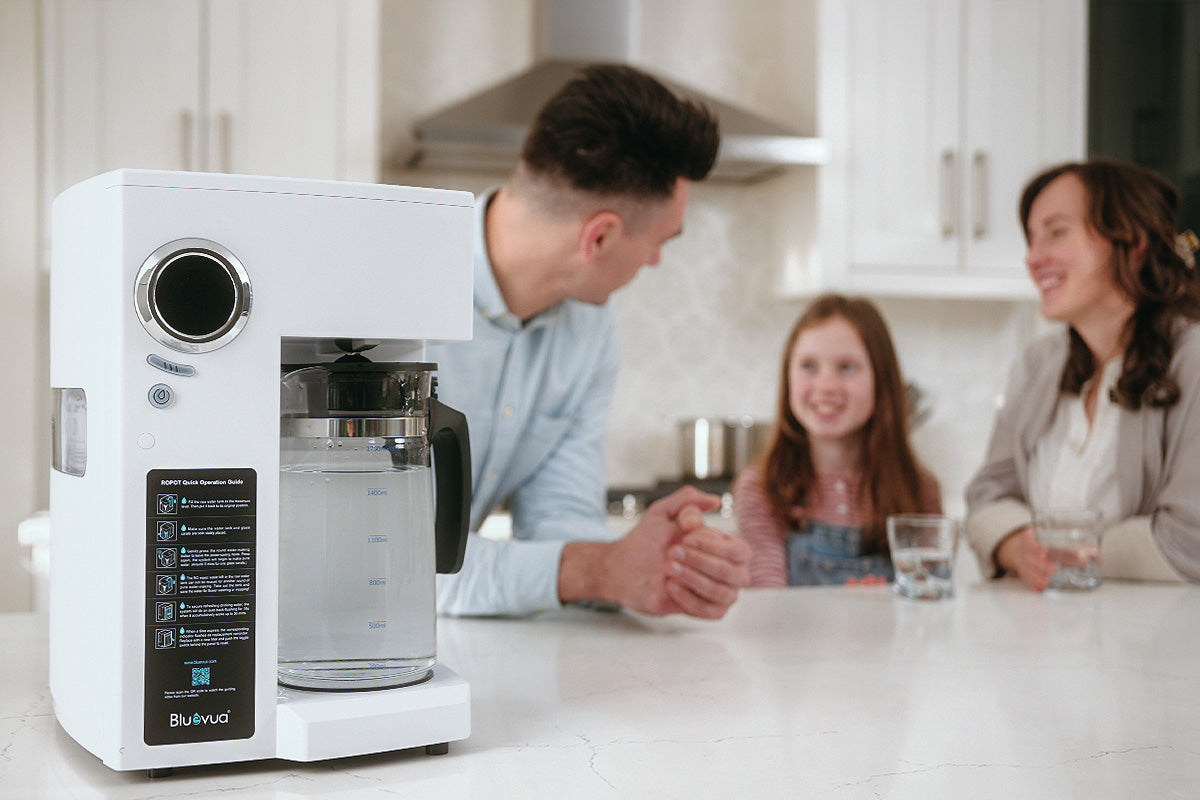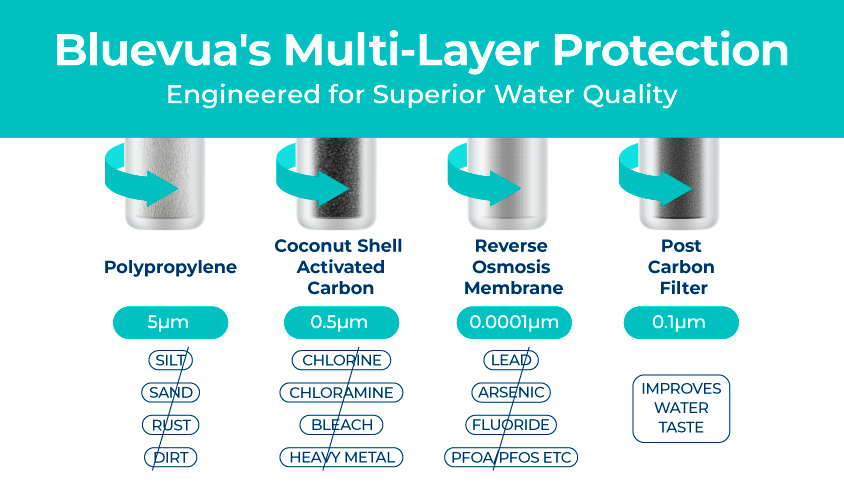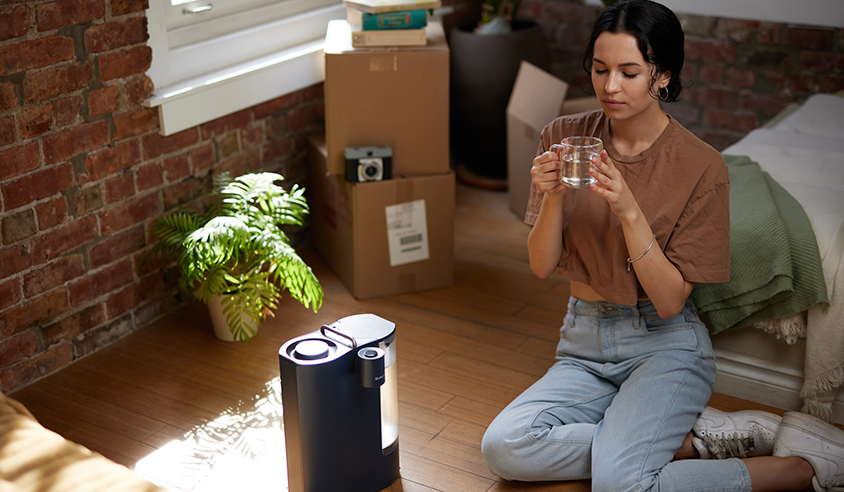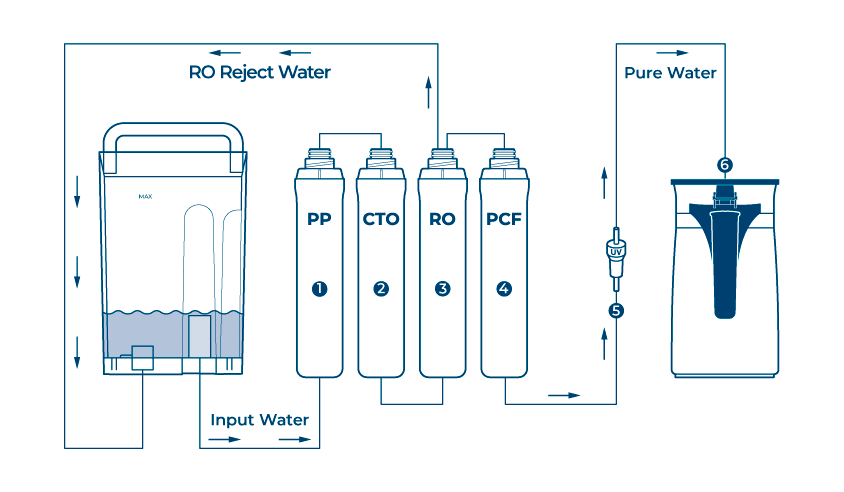Navigation
- Filter Elements: Precision in Every Layer
- When to Change Your Filters
- The Ease of Bluevua RO Filter Replacement vs. Traditional Systems
- The Uncomplicated Choice with Bluevua for RO System Care
You want to be sure you are drinking clean water; it all starts here with this filter in your reverse osmosis system. For proper functioning, these filters need to be replaced. Knowing how and when to change them can be a bit confusing. We're here to make it simple: This article will introduce you to the different types of filters, what they do, and ways to know when to replace them.

Filter Elements: Precision in Every Layer
In reverse osmosis systems, each filter plays a crucial role in ensuring the purity of your water. These filters work in unison to remove contaminants down to microscopic levels.
Filtration Accuracy Explained
1. Polypropylene Fabric (PP) – 1 μm: This fabric acts like a fine sieve, catching larger particles such as silt, sand, rust, and dirt. With a filtration accuracy of 1 micron (μm), it's the first step in the purification process, preventing these larger particles from reaching the more delicate filters downstream.
2. Coconut Shell Activated Carbon (CTO) – 0.5 μm: Crafted from coconut shells, this activated carbon filter has pores small enough to absorb smaller contaminants like chlorine, chloramine, microplastics, and certain microorganisms. With a 0.5 μm rating, it also begins the process of improving water taste and clarity.
3. Reverse Osmosis Membrane – 0.0001 μm: The star of the show, the RO membrane's incredibly tight 0.0001 μm pores strip away even the most stubborn of contaminants, including lead, arsenic, fluoride, and PFOA/PFOS. It's essentially the barrier that ensures only water molecules, and a select few other elements, can pass through.
4. Post Carbon Filter (PCF) – 0.1 μm: After the heavy lifting is done by the RO membrane, the post-carbon filter with a pore size of 0.1 μm acts as a polisher, further improving the water's taste by removing any residual impurities that may have slipped through earlier stages.

In a nutshell, the filtration accuracy of each of these layers is meticulously calibrated for specific tasks:
- PP Filter Function: Serves as the gatekeeper, removing visible particles and protecting subsequent filters.
- CTO Filter Function: A powerful purifier, it absorbs chemicals and small-size organic materials, significantly improving the safety and aesthetic quality of water.
- RO Filter Function: This is where the magic happens-the RO membrane tackles dissolved solids and harmful substances, safeguarding your health with every sip.
- PCF Filter Function: As the final touch, this filter ensures that your water not only is clean but also tastes fresh and is enjoyable to drink.
When to Change Your Filters
A key aspect of maintaining the quality of water from your reverse osmosis system is knowing when to replace the filters. Your RO system needs timely filter changes to keep running smoothly.
Signs It's Time for a Filter Swap
Slow Water Flow: If it's taking longer to fill your glass, it could be a sign that the filters are clogged and need replacing.
- Strange Tastes or Odors: If the water from your RO system starts to taste or smell off, the carbon filters might be saturated and no longer effectively remove contaminants.
- Cloudy Water Appearance: Water from an RO system should be crystal clear, except for occasional trapped air bubbles that will naturally clear up after a few minutes. Persistent cloudiness can indicate that the sediment filter is full and unable to remove all the particles anymore.
- Annual Timeline: To achieve optimal performance and water quality, adhere to the recommended replacement cycle for your RO system filters, which can vary by brand but typically falls between every six months and two years.
Waiting too long to replace your filters can put undue stress on the RO membrane, potentially shortening its lifespan and leading to costly repairs or replacements.
The Ease of Bluevua RO Filter Replacement vs. Traditional Systems
When comparing Bluevua's user-friendly design to the traditional reverse osmosis filter replacement process, several challenges are evident with the latter that can make maintenance more cumbersome:

Complicated Disassembly
Traditional RO systems often require a series of steps to properly access and remove the spent filters. This might involve unscrewing tight housings, which can be particularly challenging if they're sealed due to mineral buildup or if the user is not physically strong.
Requirement for Special Tools
Some traditional systems necessitate the use of specific tools to open the filter housings. Misplacing these tools or using incorrect ones can lead to damage or an inability to perform the necessary maintenance.
Mess and Leaks
Changing filters in traditional RO systems can be messy. Water remaining in the system can spill when filters are removed, leading to potential water damage or just an inconvenient cleanup. If the new filter isn't seated correctly, it could result in leaks when the system is turned back on.

Manual Monitoring
Without advanced monitoring, users must keep track of filter life either by noting the date of the last change or by observing the performance and quality of the water-both methods being less reliable and more time-consuming than an automated alert system.
Risk of Incorrect Installation
It's crucial to install the correct filter type in the proper location within the system. Traditional systems often have less intuitive designs, increasing the risk of incorrect installation, which can impair water quality or damage the system.
Time-Intensive Process
The whole routine of shutting off the water supply, relieving pressure, disassembling the filter housing, replacing the filter, and then reassembling everything can be quite time-intensive, deterring timely maintenance.
Potential for Cross-threading
When screwing the filter housings back into place, there's a risk of cross-threading, which can damage the threads and cause leaks. This is especially problematic as it might not be immediately noticeable and could lead to long-term issues within the system.
Regular O-ring Maintenance
O-rings need to be checked, cleaned, and lubricated or even replaced to ensure a proper seal. Neglecting this aspect can also lead to leaks and system failure.
Bluevua's innovative design streamlines the filter replacement process, mitigating these hassles and providing an overall more convenient and user-friendly experience.

The Uncomplicated Choice with Bluevua for RO System Care
Bluevua has changed reverse osmosis system maintenance through innovations that enhance user convenience and reliability. With an integrated filter life monitoring system that prompts users when a replacement is due, the guesswork is eliminated, ensuring consistent water purity. The design allows for quick, tool-free filter changes right at the countertop, devoid of any leakage risks. Especially their patented 5in1 RO Filter (used in ROPOT-Lite & ROPOT-Travel) takes simplicity further, boasting a three-second replacement time, making incorrect installation virtually impossible. Coupled with the longevity of the filters, which require changing only once per year on average, Bluevua delivers a seamless, hassle-free experience that upholds the integrity of your drinking water with minimal effort.





ทิ้งข้อความไว้
ความคิดเห็นทั้งหมดจะได้รับการตรวจสอบก่อนที่จะเผยแพร่
เว็บไซต์นี้ได้รับการคุ้มครองโดย hCaptcha และมีการนำนโยบายความเป็นส่วนตัวของ hCaptcha และข้อกำหนดในการใช้บริการมาใช้